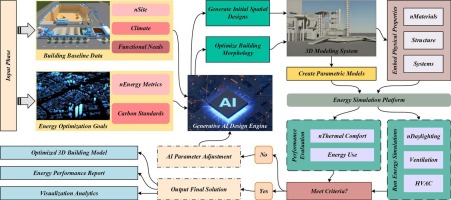In view of the global energy requirement, escalating and environmental problems intensify, the energy efficiency and the reduction of carbon emissions has become critical in today's society [1]. Rapid progress in technologies for artificial intelligence (AI) and machine learning (ML) have recently changed the traditional research and development paradigm to energy materials [2]. By using the powerful computing capabilities of AI and ML, researchers can achieve a more precise analysis and optimization of energy materials, especially in key areas such as energy storage, energy conversion and intelligent grids. This AI-controlled intelligent technology for energy materials offers new methods for efficient energy use and sustainable development.
As a decisive means of achieving energy optimization and sustainable development, intelligent buildings are increasingly becoming the heart of contemporary urban planning. With the continuous improvement of the standards for the energy efficiency of buildings [3]. By using 3D modeling technology, architecture designers can simulate and use the performance of building energy efficiency to optimize spatial layouts and reduce energy consumption, creating more energy-efficient and environmentally friendly architectural designs [4]. Energy optimization in intelligent buildings exceeds traditional energy -saving measures and achieves optimal energy supply efficiency through precise model forecasts and intelligent management systems.
When designing intelligent buildings, the decisive aspect lies in the selection and use of energy materials. AI technology supports designers in optimizing the selection of materials and supporting efficient, environmentally friendly materials by analyzing the physical properties and the energy efficiency of building materials. The auxiliary role of AI is particularly prominent in the areas of energy storage and conversion [5]. By refining the design of battery materials, AI can improve the performance of energy storage systems, extend the lifespan of the battery and play a crucial role in smart grids. In addition, AI makes it easier to optimize conversion material designs such as solar cells, thermoelectric materials and fuel cells, which improves energy efficiency and the extension of the lifespan.
This study introduces a new design methodology to optimize energy consumption in buildings through the integration of generative AI technology into 3D modeling. In contrast to conventional approaches to construction design, which often overlook the dynamic nature of energy consumption, our method uses real -time data and several optimization rounds to themeratively improve both spatial layouts and energy efficiency. This AI-controlled approach offers several advantages over existing techniques, including improved adaptability itself to changing environmental conditions, a higher accuracy of the energy forecasts and the ability to seamlessly integrate advanced energy-saving materials. The integration of these technologies not only optimizes energy consumption, but also supports the development of low -carbon, sustainable building constructions.
With the further development of science and technology, models for machine learning and deep learning models are increasingly being used in optimizing renewable energies. These models enable more precise analyzes of forecasts for electricity generation from renewable sources such as wind and solar energy, which reduces energy fructives and improves system stability. At the same time, the use of AI in Smart Grids has increased the efficiency of energy management by predicting the energy requirement and the optimization of the distribution. KI not only contributes to improving energy efficiency, but also more sustainable solutions for future energy systems. The use of these technologies transforms the energy optimization of the intelligent buildings from a trend into a crucial means to achieve green and low -carbon targets. This article examined the theoretical basis of artificial intelligence and 3D modeling. Next, let's take a look at the current application status of artificial intelligence in energy optimization of intelligent buildings and how these technologies are used today.
